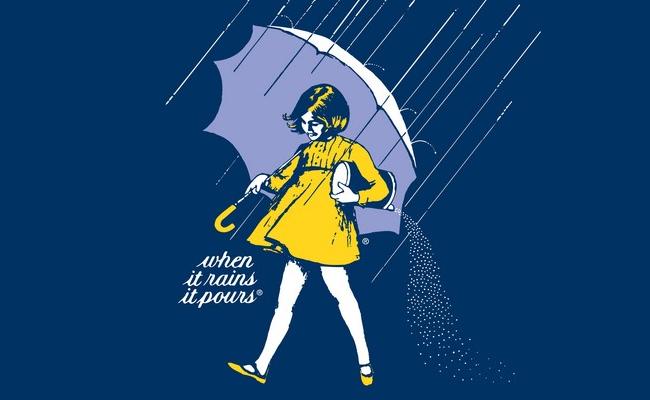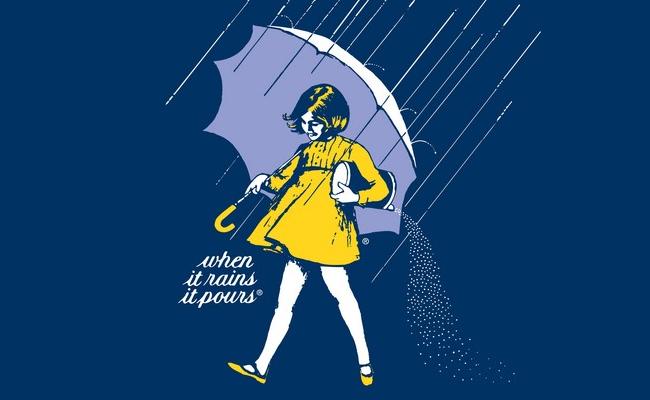Salt. Before refrigeration, when civilizations settled near rivers, and everyone praised the sun, humanity put great stock in the bane of those with high blood pressure. That is because using salt as a preservative provided the most reliable method of food preservation even into the nineteenth century when canning and iceboxes finally entered the scene.
Salt was sold as a product like any other commodity in the wake of the Industrial Revolution. Companies mined and prepared salt for various purposes, but the most common for most people is table salt, specifically kosher salt.

Morton Salt’s Origins
One such Company, perhaps the best-known one to sell salt for home use, is Morton. Their story, as the Company’s site declares, “began during the Gold Rush, which created a seemingly endless demand for salt for adventure-seekers moving west. No wonder salt has been called white gold through the ages.”
The Company started in Chicago in 1848, then known as Richmond & Company, Agents for Ondondaga Salt. Just in time to feed the California Gold Rush’s need for salt, that, and the later Civil War, propelled the Company to great success.
Fortunately, back then, a quality product could make up for a long and hard-to-remember name. Starting in the commercial hub of Chicago, where both rail and water commerce met to supply the nation and later, the world, also helped.
Starting The Morton Salt Company
In 1889 Joy Morton acquired a controlling share of the Company, renamed to the slightly shorter and catchier Joy Morton and Company. The Company would go through one more name change, and it was during this second transition, an early advertising icon entered the stage. Known as the Morton Salt Girl, she is just as iconic a character as any other food mascot and one of the oldest.
In the early 1900s, Joy Morton formally incorporated the Company into the Morton Salt Company. Since the Company had changed names again, some advertising was to help people remember who provided the best salt, the same salt they used when the name was longer.
As their site states, “It was the early days of advertising, and the company boldly decided it was time for its first national consumer advertising campaign to promote a true breakthrough – Morton’s free-flowing salt in a round blue package with a patented pouring spout.”
Including The Morton Salt Girl
The Company hired advertising firm N.W. Ayer & Company to come up with a new campaign. One of their ideas was the Morton Salt Girl, a little girl wearing yellow with an umbrella. The catchy slogan of When it Rains, it Pours was added as well, the idea being that the new spout made for easier salting.
Together, the image beautifully captured the new spout, or at least the company heads thought it did. The Morton Salt Girl and her phrase debuted in 1914. Her catchphrase and appearance proved to be an endearing success, and she continues to appear on Morton products into the twenty-first century.
How The Morton Salt Girl Changed Over Time
Still, fashions change, and the little girl’s apparel and style are updated with the times. Morton updated her appearance in 1921, 1933, 1941, 1956, 1968 and commemorated her 100th anniversary in 2014.
In 1914, she resembled Shirley Temple to a degree. 1921 replaced her boots with shoes and a massive hair bow. The bow shrank in 1933. In 1941 she replaced the bow with pigtails. In 1956 her dress became more intricate, and her umbrella became yellow instead of blue. In 1968, her hair was cropped into a stylish bob, her dress simplified, and her hair was blue instead of blond. This is more or less how she appeared for 2014, though her hair became blond again.
Regardless of her appearance, the Morton Salt Girl has remained an iconic symbol of salt. Her products reside in cabinets all over the world. From a salt company in the commercial hub of Chicago to an iconic bran mascot, Morton and the Salt Girl are well poised to continue providing easy-to-pour salt. As for what forms she may take in the future, they will probably involve the color yellow.
Referenced Sources:
- Tulip Mania – The Story of One of History’s Worst Financial Bubbles - May 15, 2022
- The True Story of Rapunzel - February 22, 2022
- The Blue Fugates: A Kentucky Family Born with Blue Skin - August 17, 2021
